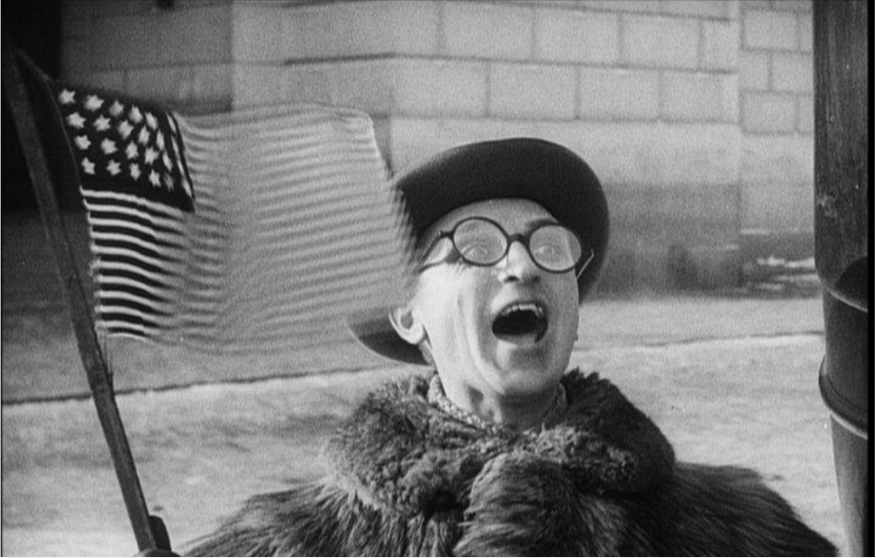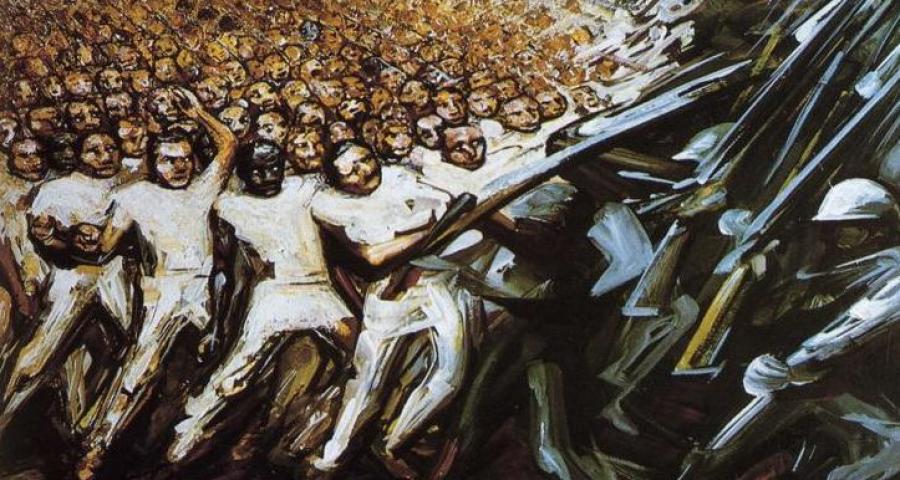The following audio is from a Red Wedge panel discussion held at Historical Materialism London in 2017, featuring Neil Davidson on “Lukacs, Greenberg and the Spectre of Trotsky,” Crystal Stella Becceril on “Affirming the New: Art of the Mexican and Russian Revolutions,” and David Mabb on “The Three Crosses.”
Read moreAmericanism as 20th Century Communism
Lev Kuleshov’s The Extraordinary Adventures of Mr. West in the Land of the Bolsheviks (1924).
Artists, radicals and radical artists have always looked at the future, the horizon, and seen a telos of emancipation. From modern-day left-accelerationism to 90s anarcho-cybernetic to prog-rock’s discovery of the synthesizer, the future has been an emancipatory muse. Owen Hatherley’s Chaplin Machine engages what could be termed an early example of left-accelerationism: the Soviet avant-garde’s absolute fascination with America. Indeed, going with Hatherley’s beautifully written and sometimes cheeky account with this fascination that, to be frank, sometimes borders on mystification, one can even reverse the aphorism of Earl Browder, the old social-patriotic leader of the American Communist Party, “Communism is 20th century Americanism.” This is to say that to those in the early Soviet avant-garde, and indeed cultural producers in general, Americanism was 20th century communism.
Read moreFlame On the Snow
Nikolai Lapshin, View of Obvodny Canal.
To regard the struggle, the pain of a revolution, is not to deny the magnificence and optimism embodied in it. In order to fully look to the future, we have to reckon with the immensity of creating it. And acknowledge that we may fail.
Victor Serge knew this. He supported the Bolshevik Revolution enthusiastically, but as he saw its direction thrown off by civil war and rising bureaucracy, he had little hesitation in dissenting while remaining in absolute solidarity.
Read moreLong Live the New!
David Mabb. Long Live the New! Morris & Co. Hand Printed Wallpapers and K. Malevich’s Suprematism, Thirty Four Drawings, including covers, addendum and afterword. Forty-nine paintings: wallpaper book covers and acrylic on wallpaper mounted on canvas, 2016.
The installation Long Live the New! Morris & Co. Hand Printed Wallpapers and K. Malevich’s Suprematism, Thirty Four Drawings, including covers, addendum and afterword is made from a combination of two books: a Morris & Co. wood block printed wallpaper pattern book from the 1970s containing 45 sample wallpaper designs by William Morris, the 19th Century English wallpaper, textile and book designer, poet, novelist and Communist; and the Russian artist and pioneer of abstraction Kazimir Malevich’s Suprematism, Thirty Four Drawings, published in 1920.
Read moreInviting One’s Self Into the Future: Two Exhibitions
We are born. It should be a start, but it is in fact a non-start; for we almost immediately have our full agency and autonomy as human beings robbed from us. We spend a lifetime trying to grasp it back from beneath a growing pile of rubble.
Rubble is literally at the center of Ilya Kabakov’s Labyrinth (My Mother’s Album). A large installation among many included in the Tate Modern’s exhibition of Ilya and Emilia Kabakov’s work, it is a spiral of long hallways reminiscent of Soviet era communal apartment buildings.
Read moreDreaming of a Hundred Years Ago: Three Sonnets
Konstantin Novakov's Where are my Seventeen? in St. Petersburg (photo by Martha Cooper).
Some things, once said, can't ever be unsaid.
Some spells, once chanted, cannot be unmade,
but spark, leap over silicon barricades,
cast afterimages of brilliant red.
The spell creates the wizard. There lies he,
babe rocked by engines, watched through robot eyes,
his cradle hung from cables to the sky,
lulled fast asleep by steam trains to the sea.
Echoes of 1917
El Lissitzky's Beat the Whites With the Red Wedge, 1920.
At 9:40pm on October 25th, the forecastle gun of the battleship Aurora fired an ear-shattering round into the air. It was a blank, an empty shell. One-year prior, the Aurora had been contributing to the carnage of World War I, patrolling and bombarding in service to the Russian Empire. Now it was docked in Petrograd and under the control of a revolutionary sailors’ committee, most of whom supported the Bolsheviks. The blank round was, so the story goes, the first shot in the October Revolution, which overthrew the Provisional Government and established the first workers’ state in history.
Read moreRealism, Modernism, and the Spectre of Trotsky, Part 1: Lukács
David Alfaro Siqueiros' Lucha por la Emancipacio.
What is the relationship between artistic movements and the historical periods during which they first appeared? Can the methods associated with these movements be detached from their original context for the benefit of later artists? Do the answers to these questions depend on which movements and periods we are discussing? The issue is of more than academic interest. Serious contemporary artists want to produce work relevant to, and critical of the societies in which they live; but in doing so, are they free to draw on any methods, from any point in history, or will only some be adequate to their needs? Should socialists expect them only to work with particular methods, and criticise them when they do not?
Read moreOctober: Ten Days That Shook the World
There are different methods of celebrating an anniversary. There is that which looks back with pure nostalgia; a soft, uncritical reification that half expects time to repeat itself. It is safe to say that the vast majority of anniversaries are celebrated in such a way.
Then there is the method of commemoration that looks forward, that intrinsically understands history as a constant process, unfolding in this way or that depending on who pushes, who is pushed, and whether they are willing to push back. Not events as blueprints, but as ruptures and openings though which we can see a different future.
Read moreRed Wedge at Historical Materialism London
Red Wedge will be presenting two panels at this year's Historical Materialism London conference. This year's conference takes place at the confluence of three auspicious anniversaries: the 20th anniversary of the HM journal, the 150h anniversary of the publication of Marx's Capital, and the 100th anniversary of the Russian Revolution.
It is no surprise to anyone familiar with Red Wedge that we share HM's commitment to Marxism's reinvention and rediscovery. Which is why we are glad to be contributing these panels, dedicated to a creative and critical assessment of the Marxist aesthetic experience.
Read moreThe Streets Are Our Palettes: A Tribute to Vladimir Mayakovsky
From newsreel footage of a Soviet parade, with a wooden model of Vladimir Tatlin's Monument to the Third International (1919-20)
One of the delights of growing up politically lies in discovering one’s own traditions. In art they were nearly obliterated by Stalinism, declared redundant by the long post-war boom and generally buried in a "modernism" which was often apolitical and trite. It was exhilarating to unearth in Soviet Russia the most genuinely modern of modern art movements and Mayakovsky, the original "hooligan communist".
Vladimir Mayakovsky, the poetic loudspeaker of the Russian Revolution, came to socialist ideas with the enthusiasm of youth. He began to read Engels and illegal pamphlets under his desk-lid when he was 12. When later the same year his school was closed by Military Edict because of the 1905 uprising, he became chief school leaflet distributor. When he made his first contact with the illegal Bolshevik Party, he immediately presented them with his forester father’s shotgun. Aged 15, he was arrested in Moscow for helping to organise the escape of political prisoners from jail and was himself held in Novimsky Prison where he began to write poems. For the following 20 years he served the Revolution as a poet-agitator with the same audacity and passion. And when he shot himself in Moscow in 1930, he died a Bolshevik, brandishing his poems:
Read more







